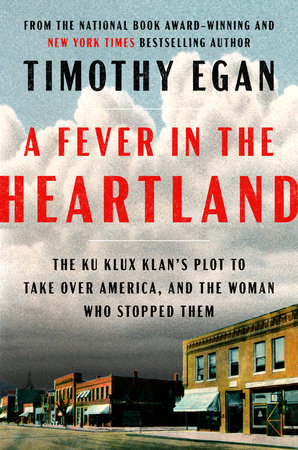I have read and enjoyed other books by Timothy Egan (The Worst Hard Time; Breaking Blue), who is one of my favorite non-fiction writers ( along with Erik Larson and Candice Millard). Among the several very competent plot summaries I read, I chose that from Library Journal:
"National Book Award and Pulitzer Prize winner Egan ... exposes a 1920s American political scene filled with characters and themes that resonate today. He unmasks anti-Black, anti-immigrant, antisemitic, fearful, evangelical, hate-filled, resentful, and xenophobic white supremacists desperate to "save" the country. He focuses on David Curtis "D.C." Stephenson (1891--1966), a magnetic charlatan with Napoleonic visions that included becoming a U.S. senator and more. Twenty-seven chapters document Stephenson's rise from a Ku Klux Klan recruiter in Evansville, IN (then the country's most racially segregated city), to Grand Dragon of Indiana, the largest KKK realm ever, with a reputed 400,000 members. Nationally, the KKK included congresspeople, governors, state legislators, county and local officials, police, and more. The book details KKK insider personalities, locally and nationally, along with their corruption, scheming, and squabbling for control, money, and power. The book also chronicles Stephenson's fall as he approached the apex of power when, in a sensational and noteworthy trial, he was convicted of abducting, raping, and murdering Indiana Department of Public Instruction lending library manager Madge Oberholtzer (1896--1925). VERDICT Egan's riveting page-turner offers profound insights to readers willing to peer into layers of American hypocrisy, intolerance, malignant indifference, and public culpability.-"
Publishers Weekly adds this information about significance of Madge Oberholtzer's ordeal: "During the incident, Oberholtzer dosed herself with bichloride of mercury; she died an agonizingly slow death 29 days later, but not before she dictated a full account of Stephenson's crimes. Convicted of second-degree murder and sentenced to life in prison, Stephenson became a symbol of the Klan's cruelty, hypocrisy, and corruption, and the organization's grip on Midwestern politics crumbled."
I have only lately become aware of the KKK's resurgence during the 1920's after they went underground following their reign of terror during Reconstruction. For example, I just read The Paragon Hotel, which shows how strong they became in the state where I now live, Oregon, during that time.

No comments:
Post a Comment